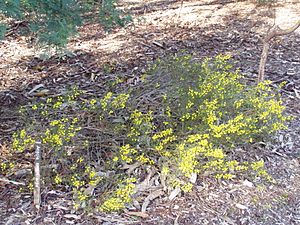Jumping jack wattle facts for kids
Quick facts for kids Jumping jack wattle |
|
|---|---|
 |
|
| Conservation status | |
| Scientific classification | |
| Genus: |
Acacia
|
| Species: |
enterocarpa
|
 |
|
| Occurrence data from AVH | |
Acacia enterocarpa, commonly known as the Jumping Jack Wattle, is a special kind of shrub. It grows only in eastern Australia, meaning it is endemic there. This plant is a unique part of Australia's natural environment.
What Does the Jumping Jack Wattle Look Like?
The Jumping Jack Wattle is a bushy shrub that spreads out. It usually grows to be less than 1.5 meters (about 5 feet) tall. Its branches are reddish-brown and have small ridges. They might feel a bit rough to the touch.
The plant has green, smooth, and stiff phyllodes. Phyllodes are like flattened leaf stalks that do the job of leaves. These phyllodes are straight or slightly curved. They are about 1.5 to 4.5 centimeters long and 1 to 1.3 millimeters wide. Each phyllode has 10 to 12 raised lines, or nerves.
This wattle blooms between May and October. It produces bright yellow, round flower-heads. Each flower-head is about 3.5 to 4.5 millimeters across and has more than 20 tiny flowers. After the flowers, brown, wavy seed pods form. These pods are tough and about 2 centimeters long and 2 millimeters wide. Inside, the seeds are dull dark brown to black. They are oblong or oval-shaped and about 3 millimeters long.
How Was the Jumping Jack Wattle Named?
The Jumping Jack Wattle was first officially described by a botanist named R.V. Smith in 1957. He wrote about it in a paper called A remarkable new Acacia for Victoria (The "Jumping-Jack" Wattle).
For a short time in 2003, it was reclassified into a different group called Racosperma enterocarpum by Leslie Pedley. But in 2005, it was moved back to the Acacia group, where it is today.
The second part of its scientific name, enterocarpa, comes from Greek words. "Entero" means "intestines" and "karpos" means "fruit." This name refers to the wavy, intestine-like shape of its seed pods. The Jumping Jack Wattle is closely related to other wattles like Acacia colletioides and Acacia nyssophylla.
Where Does the Jumping Jack Wattle Grow?
The Jumping Jack Wattle grows in a few separate areas in south-eastern South Australia and western Victoria. You can find it on the southern tip of the Eyre Peninsula and Yorke Peninsula. It also grows near Curramulka and Bordertown, extending east to Nhill in western Victoria.
This shrub often grows in woodlands or open forests. It can be found in different types of soil. It likes sandy soils that are alkaline (not acidic). It also grows in neutral yellow soils, red loamy soils, and grey clay soils that crack when dry.


